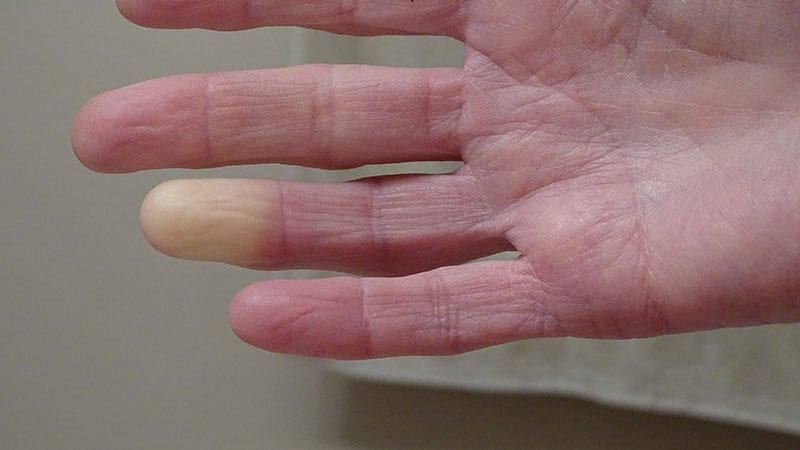TOPLINE:
While Raynaud phenomenon is often the initial clinical manifestation of systemic sclerosis (SSc), over 30% of patients in two large US cohorts presented first with other manifestations — predominantly puffy fingers and hands. These patients exhibited more severe skin disease and increased joint contractures than those showing Raynaud as their initial symptom.
METHODOLOGY:
- Researchers analyzed data from two large US cohorts to assess the clinical features of SSc in patients whose first manifestation was a non-Raynaud symptom.
- They included 1377 patients older than 18 years with SSc who were diagnosed within 5 years of their first non-Raynaud symptom and met standardized SSc classification criteria.
- Date on baseline demographics, clinical features (such as skin involvement, joint contractures, and tendon friction rubs), and the presence of specific autoantibodies were collected.
- Serologic testing was performed for antinuclear antibodies and SSc-specific autoantibodies using HEp-2 indirect immunofluorescence assay and other specific laboratory or clinical assays.
TAKEAWAY:
- In both the cohorts, 31%-44% of patients had a non-Raynaud symptom — most commonly puffy fingers or hands — as their initial sign of SSc preceding the onset of Raynaud phenomenon.
- Black patients were more likely to present with non-Raynaud symptoms as their first manifestation than patients from other racial and ethnic backgrounds.
- Patients who initially presented with non-Raynaud symptoms had a significantly higher prevalence of diffuse cutaneous involvement, joint contractures, and tendon friction rubs at baseline.
- In both cohorts, RNA polymerase III antibody was significantly more prevalent in patients who presented with non-Raynaud phenomenon first than in those who presented with Raynaud phenomenon first (P <.01 for both cohorts).
IN PRACTICE:
“Future research aimed at understanding and/or treating patients in the early stages of SSc should be inclusive of those presenting without [Raynaud phenomenon] if other risk features (eg, puffy fingers/hands, abnormal nailfold capillaries, skin tightening, tendon friction rubs, positivity for ANA and SSc-associated specific autoantibodies) are present,” the authors wrote.
SOURCE:
This study was led by Iqtidar Hanif, MD, MS, UTHealth Houston Division of Rheumatology, Houston, Texas. It was published online on May 19, 2025, in Arthritis & Rheumatology.
LIMITATIONS:
The study relied on patient recall, which may have introduced bias and imprecision in reporting symptom onset. There was also a lack of standardization across sites in assessing the presence of Raynaud phenomenon. Additionally, the findings may be influenced by referral bias, as patients seen at academic medical centers are often referred by other rheumatologists or seek second opinions independently.
DISCLOSURES:
One of the cohorts was supported by the Scleroderma Research Foundation, and some authors reported receiving grants from the National Institute of Arthritis and Musculoskeletal and Skin Diseases. Some authors reported receiving financial support, grants, or consulting fees from various pharmaceutical companies.
This article was created using several editorial tools, including AI, as part of the process. Human editors reviewed this content before publication.
Source link : https://www.medscape.com/viewarticle/puffy-fingers-or-hands-often-precede-raynaud-phenomenon-2025a1000gb9?src=rss
Author :
Publish date : 2025-06-18 18:39:00
Copyright for syndicated content belongs to the linked Source.
